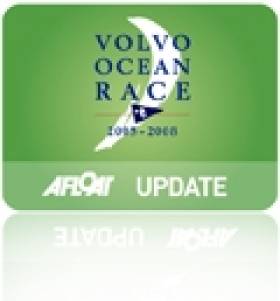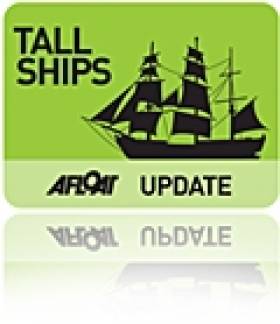Displaying items by tag: spectators
Countdown to VOR Begins in Galway
The countdown to the arrival of the Volvo Ocean Race in Galway begins tomorrow night in the City of the Tribes.
The Galway Advertiser reports that TV personality Hector O’Heochagain will be on hand for the countdown party in the Galway Bay Hotel to unveil the digital clock that will tick down the seconds till the race's arrival on 3 July next year.
Around 600,000 spectators were drawn to the city for the previous race visit in May 2009, bringing in more than €55 million to the local economy.
For next year's event there are plans to divide the city into nine distinct areas to mark the culture of each of the stops on the Volvo Ocean Race.
The Royal St George Yacht Club has described the entertainment package for the upcoming International Match Racing Challenge as "value for money".
As reported Friday on Afloat.ie, the club is charging €200 for its 'hot seat' package, which will put yacht racing fans on board with a team "experiencing the thrills and tension of the race as it happens along with the competitors".
But the RSGYC has pointed out that the package, while expensive, works out as good value.
"We are very conscious of asking anyone to pay for anything but the package includes a lot - lunch, dinner, drinks, sailing, hot seat sailing, goodie bag, embroidered gear, etc," said RSGYC marketing and events co-ordinator Sonja Lee. "It is expensive but personally I feel it's value for money."
She added: "The feedback from last year’s hot seaters was excellent and quite a few are coming back this year. Nobody complained or felt it was bad value. Pricing is on a par with other 'corporate days'."
The 'hot seat package' includes a meet-and-greet in the clubhouse, a race briefing and a yacht trip around Dublin Bay as well as the hot seat race with a competing crew. Lunch and a post-race barbecue and drinks are also provided.
Meanwhile, the similarly specced 'pure spectator' package for €100 replaces the hot seat race with the chance to fire the starting gun for one of the weekend's races.
Further details are available on the RSGYC website.
Match Racing Challenge Hot Seat a Pricey Gift
You could be in the hot seat at next month's International Match Racing Challenge - provided you'e got €200 to spend.
The top-level entertainment package for the Royal St George Yacht Club's second annual event, set for the weekend of 23-24 July, will put yacht racing fans on board with a team "experiencing the thrills and tension of the race as it happens along with the competitors".
A spectator package - which will set fans back €100 - gives a bird's-eye view of all the racing in Scotsman's Bay "as well as the added bonus of firing the starting gun", according to the RSGYC.
The second International Match Race Challenge will see Ireland’s top six match racing teams go head to head against a world team consisting of six international crews from France, Germany, Australia, New Zealand and the UK. Ireland will be hoping to avenge their 36-29 loss to the world at last year's inaugural event.
Match racing involves head-to-head racing between two identical boats over short 20 minute courses, with each boat having four crew members. At the end of the competition and after approximately 90 races, there will be an overall individual winner. In addition, the combined scores of the six Irish teams and the six international teams will deliver an overall team winner.
Package One
THE HOT SEAT
€200 per person
Experience the thrills and tension of the race as it happens aboard!
12:00 Meet and Greet in Club
12:30 Race Briefing and Intro to the Event
12:45 Light Lunch
13:30 Trip on Yacht around Dublin Bay
14:30 Arrive at Spectator area to watch racing
15:00 Hot Seat Race
16:15 Return to shore
16:30 BBQ and Drinks
Hot Seaters need to be prepared to get wet and be active!
Package Two
PURE SPECTATOR
€100 per person
Get a Bird's Eye view of all the action!
12:00 Meet and Greet in Club
12:30 Race Briefing and Intro to the Event
12:45 Light Lunch
13:30 Trip on Yacht around Dublin Bay
14:30 Arrive at Spectator area to watch racing
15:00 Step on Board the Starter's Boat and fire the Starting Gun
16:00 Return to shore
16:30 BBQ and Drinks
Requirements for Recreational Craft at Tall Ships Races
The latest Marine Notice from the DTTAS includes important information for recreational craft expected to attend the Tall Ships Races in Waterford from 30 June to 3 July.
Race organisers and the Waterford harbour master have issued an approved water safety plan for the marshalling of spectator boats for the time the tall ships are in port and for the start of the race off Hook Head.
Skippers and crew must comply with all instructions and be aware of their obligations under existing maritime legislation (regarding avoidance of collisions, preventing reckless behaviour and ensuring correct safety equipment is on board).
Boat owners intending to visit should contact the harbour master for details on restricted areas and berthing spots via the Port of Waterford website or directly at 051 974 907.
Restrictions are also in place for passenger boats and ships. Only fully licenced vessels with plying limits listing Waterford as a point of departure are allowed to operate during the event. Temporary changes in plying limits can be made via the Marine Survey Office before 15 June.
Further details are available on Marine Notice No 28 of 2011 which is available to read or download HERE.
Just One Week To Go Till Red Bull Flugtag
The Red Bull Flugtag celebrates its 100th event in Dun Laoghaire next Sunday, and organisers have posted details for spectators planning to spend the day cheering on those magnificent flying machines!
The site for the free event will open at 12 noon, with the show taking place from 1pm till 4.30pm. All public access to the event site is via Dun Laoghaire Harbour/East Pier beside the National Yacht Club (the viewing area for those with disabilities is on Carlisle Pier beside the Royal St George).
There are a number of road diversions and parking restrictions to be aware of, full details of which are listed HERE. Temporary signage will advise motorists of impending diversions, and there is ample parking available at the Pavilion, Bloomfields and the IMC cinemas.
Visitors can also arrive by public transport, with bus routes 7, 7a, 46a, 75 and 111 all running to Dun Laoghaire. DART services will also run every 30 minutes and extra capacity will be provided.
The organisers wish to remind all spectators that the Red Bull Flugtag is a family event, and the consumption of alcohol in public will not be permitted.
Watch the world flugtag record being set in Minnesota last year. Maybe a new one will be set in Dun Laoghaire next weekend?
































































